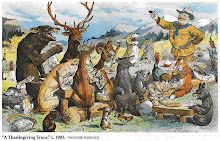Study finds cougars avoid wolf territory
Cats also live nearer to roads than thought.
POSTED: WEDNESDAY, JUNE 18, 2014 4:30 AM
By Mike Koshmrl | 0 comments
Jackson Hole's mountain lions spend a disproportionate amount of time in parts of their territory that are far from wolves, new research by the Teton Cougar Project shows.
The Kelly research group's paper "Home range characteristics of a subordinate predator: selection for refugia or hunt opportunity?" was published in the Journal of Zoology in late May.
Among other findings the research shows that lions tend to distance themselves from wolves, a competing species that sometimes kills cougars. "If you look at what's called the core home range, it tends to be farther from wolves than the rest of their home range," said Patrick Lendrum, a Cougar Project biologist and the lead author of the study.
Individual mountain lions frequent the core areas within their home ranges the most, Lendrum said.
Because wolves select top-tier territories with the most available prey, subordinate mountain lions are being pushed away from the most productive parts of the landscape, Cougar Project team leader Mark Elbroch said. "There is a reduction in habitat in the sense that they are prioritizing habitat differently," Elbroch said.
Female cats, he said, particularly select for home ranges that are thick with prey and that are distanced from wolves. That's also the case with males, which occupied home ranges 1.9 to 3.3 times larger than the females, according to the study. "All cougar home ranges were farther from the centroid of known wolf pack territories than expected when compared with the study area," the paper said.
"Spatial displacement between wolves and cougars has been noted in several other studies," it said. "This, no doubt, limits the availability of quality habitat in the Southern Yellowstone Ecosystem, which has implications for juvenile cougar survival, juvenile dispersal success and overall cougar population dynamics."
The Journal of Zoology study, which used 11 years of GPS and very-high-frequency data from 28 collared animals, also came to several other conclusions. Lion home ranges did not definitely increase or decrease in size based on the availability of prey or the percentage of the habitat that was forested.
There was "mixed support" for the hypothesis that mountain lions would select home ranges that were more rugged, steep and treed — all sources of refuge — than expected compared with the study landscape as a whole.
Both female and male cats also tended to occupy home ranges nearer to roads than researchers had expected, the paper said.
The recently completed home range study relied mostly on larger, landscape-level data, Elbroch said.
The Cougar Project plans to piggyback on the Journal of Zoology paper with a new study that will use precision real-time data from GPS-collared wolves and lions to look at "fine-scale interactions" between the two predators."
"With this new opportunity, in three years we may actually disprove everything we think we're learning now," Elbroch said. "It'll be great.












No comments:
Post a Comment